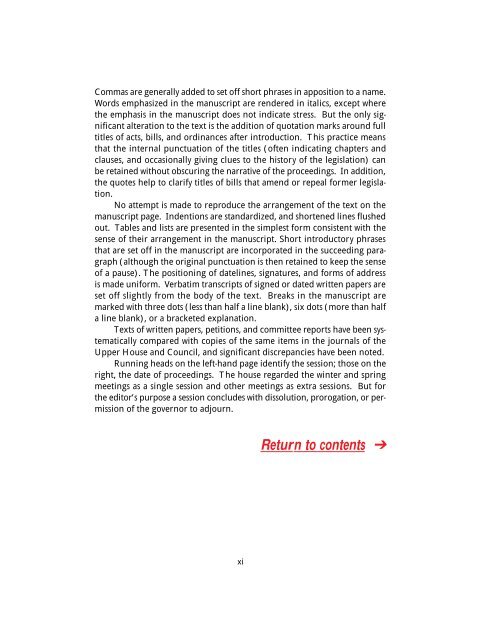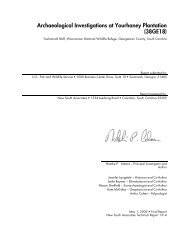eprint <strong>the</strong>se journals in volumes that will correspond in form with <strong>the</strong> o<strong>the</strong>rsin <strong>the</strong> present series and to include <strong>the</strong> pre-1736 volumes that have neverbeen printed. To accomplish this it has been found necessary to dispensewith volume numbers and to designate each volume merely by <strong>the</strong> dates <strong>of</strong><strong>the</strong> General <strong>Assembly</strong>.In <strong>the</strong> earlier volumes <strong>of</strong> this series, <strong>the</strong> editorial policy was to present<strong>the</strong> texts <strong>of</strong> <strong>the</strong> journals in <strong>the</strong> same style that a contemporary printer wouldhave used. This manner <strong>of</strong> presentation was so influenced by Dr. Easterby’sindividual editorial style that <strong>the</strong> present editor has found it necessary toadopt a more conventional expanded style. O<strong>the</strong>rwise, <strong>the</strong> format <strong>of</strong> <strong>the</strong> serieshas been left essentially unchanged. Somewhat fuller annotation is usedthan formerly, but no attempt has been made to supply comprehensive backgroundinformation in footnotes. Aside from textual matters, <strong>the</strong> notes areintended to clarify passages in <strong>the</strong> manuscript, to encourage a perceptivereading <strong>of</strong> <strong>the</strong> text, and to cite relevant material from o<strong>the</strong>r records.<strong>The</strong> printed version <strong>of</strong> <strong>the</strong> <strong>Commons</strong> <strong>House</strong> <strong>Journal</strong> essentially reproduces<strong>the</strong> complete text <strong>of</strong> <strong>the</strong> manuscript. <strong>The</strong> marginal summaries areomitted, but <strong>the</strong>y are carefully checked for significant information, and areused in editing <strong>the</strong> text. Writs <strong>of</strong> election are transcribed in full on <strong>the</strong>ir firstappearance in each volume; subsequent writs are printed in <strong>the</strong> form <strong>of</strong> abstracts.<strong>The</strong> title pages and running heads <strong>of</strong> <strong>the</strong> manuscript are replacedby new ones in <strong>the</strong> printed journal, and a new list <strong>of</strong> members done in <strong>the</strong>usual format <strong>of</strong> <strong>the</strong> series is substituted for <strong>the</strong> clerk’s own list <strong>of</strong> members.<strong>The</strong> editor’s general rule is to reproduce, as nearly as practicable, <strong>the</strong>text <strong>the</strong> clerk intended to write. Obvious slips <strong>of</strong> <strong>the</strong> pen are silently corrected.Brackets are used to draw attention to words or passages accidentallyomitted in <strong>the</strong> manuscript, matter reconstructed from damagedportions <strong>of</strong> <strong>the</strong> record, and any phrases supplied by <strong>the</strong> editor that a slip <strong>of</strong><strong>the</strong> pen has left open to question. Editorial interpolations (such as “[sic]”or “[torn]” always appear in italics.Except for rare instances where a slight change can clarify a passage,<strong>the</strong> original spelling and capitalization are retained, and a generally conservativeapproach is taken toward changes in punctuation. Contracted wordsmarked by a tilde (~) or occurring at <strong>the</strong> end <strong>of</strong> a line are spelled out, butintended abbreviations <strong>of</strong> titles, honorifics, measures, names, dates, and sucho<strong>the</strong>r words as may commonly be abbreviated today, are kept. Superscriptletters are brought down to <strong>the</strong> normal line, and <strong>the</strong> symbols “y” and “ ”rendered as “th” and “per,” “pre,” or “pro.” Abbreviated common nouns arespelled out. Where some additional point <strong>of</strong> punctuation is necessary (asat <strong>the</strong> end <strong>of</strong> a sentence or an abbreviation) one is supplied, and superfluouspunctuation marks (e.g., colons after non-abbreviations) are deleted.x
Commas are generally added to set <strong>of</strong>f short phrases in apposition to a name.Words emphasized in <strong>the</strong> manuscript are rendered in italics, except where<strong>the</strong> emphasis in <strong>the</strong> manuscript does not indicate stress. But <strong>the</strong> only significantalteration to <strong>the</strong> text is <strong>the</strong> addition <strong>of</strong> quotation marks around fulltitles <strong>of</strong> acts, bills, and ordinances after introduction. This practice meansthat <strong>the</strong> internal punctuation <strong>of</strong> <strong>the</strong> titles (<strong>of</strong>ten indicating chapters andclauses, and occasionally giving clues to <strong>the</strong> history <strong>of</strong> <strong>the</strong> legislation) canbe retained without obscuring <strong>the</strong> narrative <strong>of</strong> <strong>the</strong> proceedings. In addition,<strong>the</strong> quotes help to clarify titles <strong>of</strong> bills that amend or repeal former legislation.No attempt is made to reproduce <strong>the</strong> arrangement <strong>of</strong> <strong>the</strong> text on <strong>the</strong>manuscript page. Indentions are standardized, and shortened lines flushedout. Tables and lists are presented in <strong>the</strong> simplest form consistent with <strong>the</strong>sense <strong>of</strong> <strong>the</strong>ir arrangement in <strong>the</strong> manuscript. Short introductory phrasesthat are set <strong>of</strong>f in <strong>the</strong> manuscript are incorporated in <strong>the</strong> succeeding paragraph(although <strong>the</strong> original punctuation is <strong>the</strong>n retained to keep <strong>the</strong> sense<strong>of</strong> a pause). <strong>The</strong> positioning <strong>of</strong> datelines, signatures, and forms <strong>of</strong> addressis made uniform. Verbatim transcripts <strong>of</strong> signed or dated written papers areset <strong>of</strong>f slightly from <strong>the</strong> body <strong>of</strong> <strong>the</strong> text. Breaks in <strong>the</strong> manuscript aremarked with three dots (less than half a line blank), six dots (more than halfa line blank), or a bracketed explanation.Texts <strong>of</strong> written papers, petitions, and committee reports have been systematicallycompared with copies <strong>of</strong> <strong>the</strong> same items in <strong>the</strong> journals <strong>of</strong> <strong>the</strong>Upper <strong>House</strong> and Council, and significant discrepancies have been noted.Running heads on <strong>the</strong> left-hand page identify <strong>the</strong> session; those on <strong>the</strong>right, <strong>the</strong> date <strong>of</strong> proceedings. <strong>The</strong> house regarded <strong>the</strong> winter and springmeetings as a single session and o<strong>the</strong>r meetings as extra sessions. But for<strong>the</strong> editor’s purpose a session concludes with dissolution, prorogation, or permission<strong>of</strong> <strong>the</strong> governor to adjourn.Return to contents ➔xi







